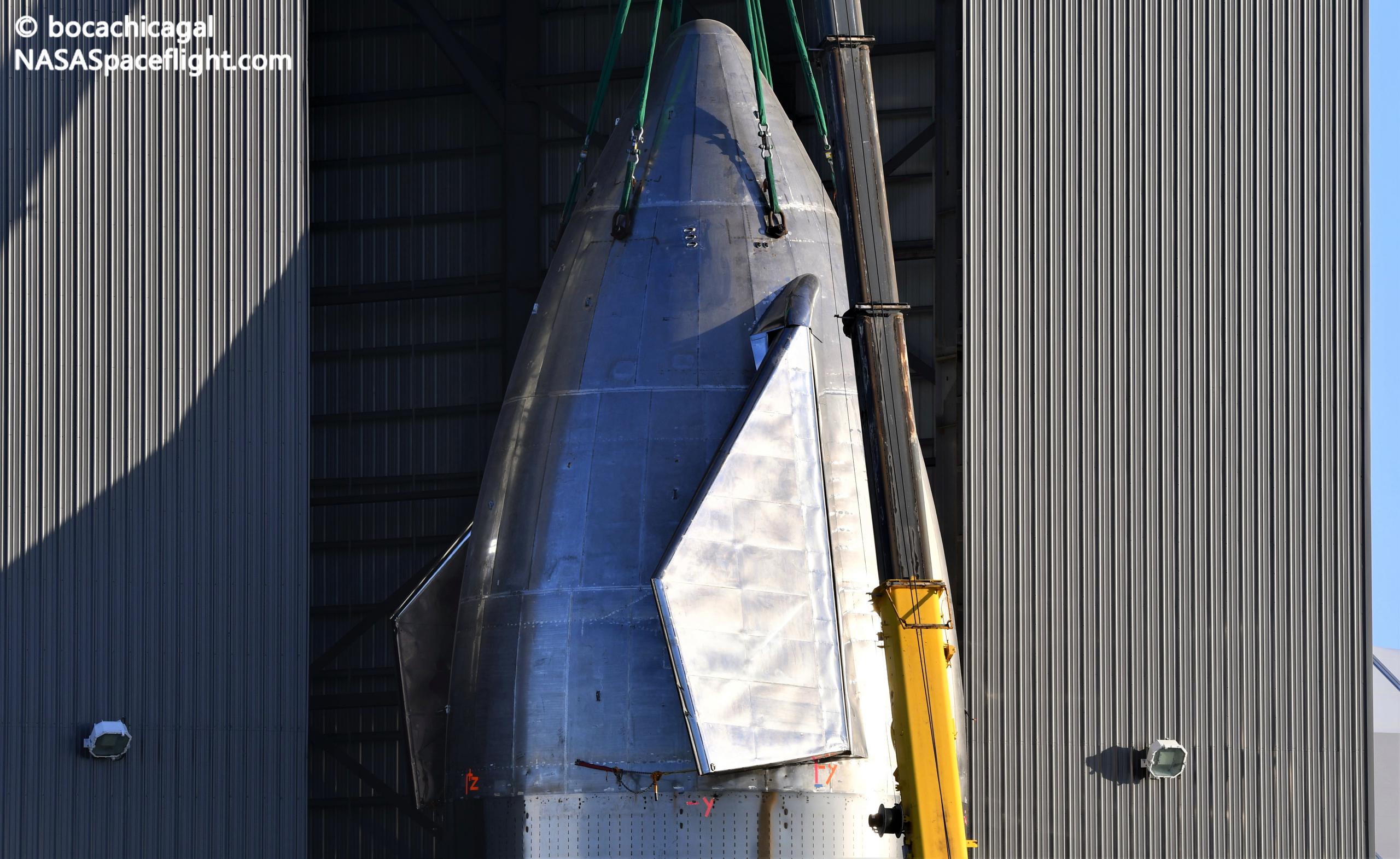
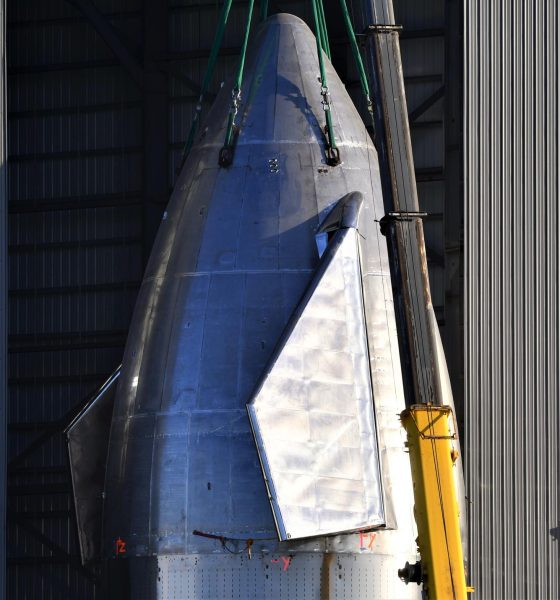
News
SpaceX Starship go for nosecone installation after historic static fire
SpaceX CEO Elon Musk has confirmed that Starship and Raptor’s first triple-engine static fire was a success, opening the door for nosecone installation.
Around 3:13 am CDT, October 20th, Starship serial number 8 (SN8) successfully fired up three Raptor engines less than two hours after completing the first successful three-engine preburner test. With zero direct human intervention, SpaceX remotely detanked the rocket’s cryogenic liquid methane and oxygen propellant – the remnants now too warm to be used again in a controlled manner. In an hour or less, SpaceX engineers combed through the data produced and concluded that all three Raptor engines were healthy after their partial ignition test.
Effectively reset to a stable state, SpaceX once again proceeded to load Starship SN8’s propellant tanks with a small amount of supercooled LOx and LCH4, almost exactly mirroring the preburner test. Around 50 minutes after the recycle commenced and 25 minutes after propellant loading kicked off, Starship SN8 ignited three Raptors simultaneously – a major milestone for any rocket engine. Static fire now completed, Starship SN8 has been cleared to become the first operational prototype to reach its full 50m (~165 ft) height.
Shortly before Musk confirmed SN8’s static fire success, SpaceX canceled a preexisting October 20th static fire window and scheduled several new road closures on Wednesday, October 21st. Unlike the company’s recent static fire closures, all but one of which ran from 9pm to 6am, SpaceX’s new Wednesday closures are scheduled from 7am to noon and 3pm to 5pm local (CDT).
While a minor data point, in context with Starship SN8’s static fire success, the closures alone made it clear that SpaceX planned to begin installing Starship SN8’s nosecone on October 21st. Musk confirmed that assumption a few hours after those road closures were published.
It’s not entirely clear but most observers are assuming that Wednesday’s 7am-12pm window is needed to transport a large, new crane the ~2 miles between SpaceX’s Boca Chica factory and launch facilities. Starship SN8’s stacked nose section would then likely be installed on the same self-propelled mobile transporters (SPMT) and rolled to the launch pad from 3pm to 5pm, after which the nose would be lifted and stacked atop Starship SN8.
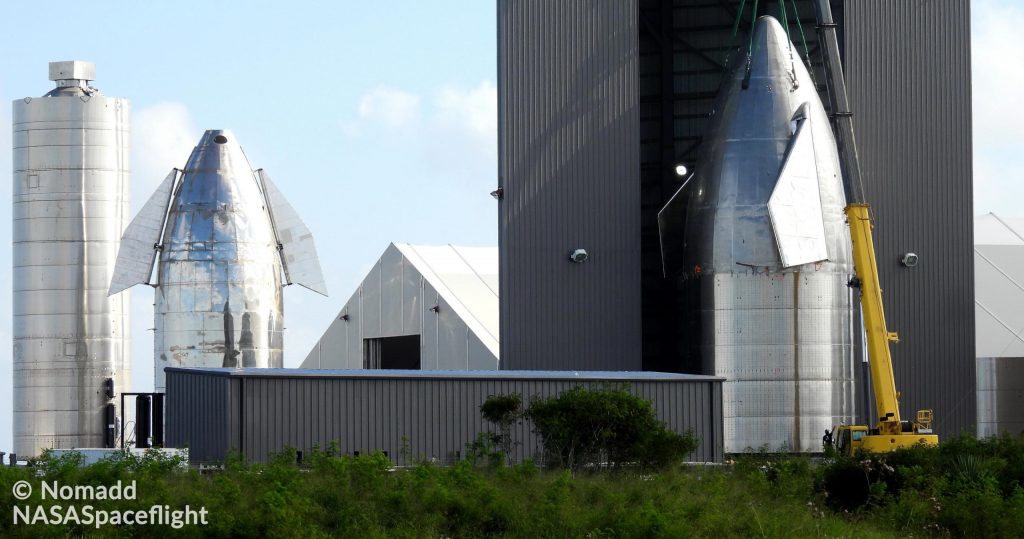
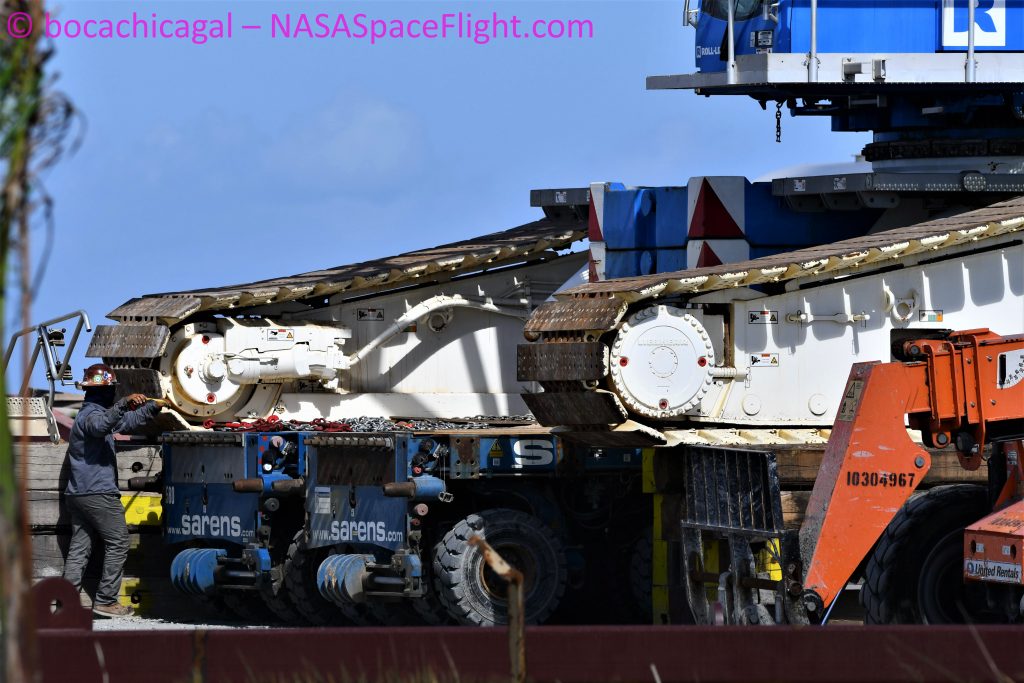
SpaceX has only fully stacked a Starship prototype once before when Mk1’s nose section was temporarily mated to its tank section to be the centerpiece of CEO Elon Musk’s October 2019 Starship event. It’s unclear why SpaceX wouldn’t simply use one of the mobile cranes its rented for Starship tank section operations (and stacking Mk1) in the past, so it remains to be seen what Wednesday’s road closures will actually be used for.
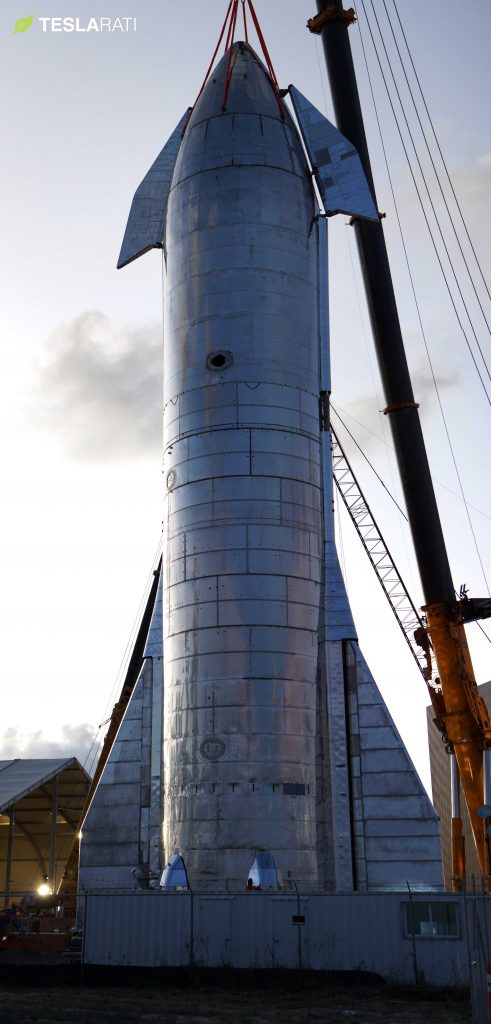
SpaceX’s road closure plans end with a wildcard, however. Once installed, the plan is to perform a second triple-Raptor static fire while only drawing propellant from SN8’s header tanks – small internal tanks designed to hold landing propellant, one of which is situated at the tip of Starship’s nosecone. On October 21st and 22nd, SpaceX still has two 9pm-6am closures scheduled for “SN8 static fire” testing. Filed early on October 20th, before SN8’s successful static fire, the most likely explanation is a simple clerical error or miscommunication, with Cameron County or SpaceX failing to properly communicate that those subsequent static fire test windows are no longer needed.
If retaining the static fire closures was intentional, it would mean that SpaceX – likely at Musk’s urging – intends to install Starship SN8’s nosecone in a matter of hours. It’s almost inconceivable that Starship SN8’s nosecone – outfitted with multiple gas thrusters, forward flaps powered by Tesla motors, a liquid oxygen header tank, vents, and plenty of plumbing – can be installed and made ready for testing in less than 12 hours. Barring a surprise method of mating SN8’s nose and tank sections, the nosecone will have to be welded to the rest of SN8 and the weld inspected – typically a multi-day process.

Regardless, given how quickly SpaceX moves and how dead-set CEO Elon Musk is at pushing limits and breaking barriers, it seems reasonable to assume that Starship SN8 may be fully integrated and ready for a second static fire test just a handful of days from now. Once completed, SN8 will be ready to attempt Starship’s first high-altitude flight test, launching to ~15 km (~9.3 mi) to attempt an untested skydiver-style descent and landing.

Elon Musk
Starlink passes 9 million active customers just weeks after hitting 8 million
The milestone highlights the accelerating growth of Starlink, which has now been adding over 20,000 new users per day.

SpaceX’s Starlink satellite internet service has continued its rapid global expansion, surpassing 9 million active customers just weeks after crossing the 8 million mark.
The milestone highlights the accelerating growth of Starlink, which has now been adding over 20,000 new users per day.
9 million customers
In a post on X, SpaceX stated that Starlink now serves over 9 million active users across 155 countries, territories, and markets. The company reached 8 million customers in early November, meaning it added roughly 1 million subscribers in under seven weeks, or about 21,275 new users on average per day.
“Starlink is connecting more than 9M active customers with high-speed internet across 155 countries, territories, and many other markets,” Starlink wrote in a post on its official X account. SpaceX President Gwynne Shotwell also celebrated the milestone on X. “A huge thank you to all of our customers and congrats to the Starlink team for such an incredible product,” she wrote.
That growth rate reflects both rising demand for broadband in underserved regions and Starlink’s expanding satellite constellation, which now includes more than 9,000 low-Earth-orbit satellites designed to deliver high-speed, low-latency internet worldwide.
Starlink’s momentum
Starlink’s momentum has been building up. SpaceX reported 4.6 million Starlink customers in December 2024, followed by 7 million by August 2025, and 8 million customers in November. Independent data also suggests Starlink usage is rising sharply, with Cloudflare reporting that global web traffic from Starlink users more than doubled in 2025, as noted in an Insider report.
Starlink’s momentum is increasingly tied to SpaceX’s broader financial outlook. Elon Musk has said the satellite network is “by far” the company’s largest revenue driver, and reports suggest SpaceX may be positioning itself for an initial public offering as soon as next year, with valuations estimated as high as $1.5 trillion. Musk has also suggested in the past that Starlink could have its own IPO in the future.
News
NVIDIA Director of Robotics: Tesla FSD v14 is the first AI to pass the “Physical Turing Test”
After testing FSD v14, Fan stated that his experience with FSD felt magical at first, but it soon started to feel like a routine.

NVIDIA Director of Robotics Jim Fan has praised Tesla’s Full Self-Driving (Supervised) v14 as the first AI to pass what he described as a “Physical Turing Test.”
After testing FSD v14, Fan stated that his experience with FSD felt magical at first, but it soon started to feel like a routine. And just like smartphones today, removing it now would “actively hurt.”
Jim Fan’s hands-on FSD v14 impressions
Fan, a leading researcher in embodied AI who is currently solving Physical AI at NVIDIA and spearheading the company’s Project GR00T initiative, noted that he actually was late to the Tesla game. He was, however, one of the first to try out FSD v14.
“I was very late to own a Tesla but among the earliest to try out FSD v14. It’s perhaps the first time I experience an AI that passes the Physical Turing Test: after a long day at work, you press a button, lay back, and couldn’t tell if a neural net or a human drove you home,” Fan wrote in a post on X.
Fan added: “Despite knowing exactly how robot learning works, I still find it magical watching the steering wheel turn by itself. First it feels surreal, next it becomes routine. Then, like the smartphone, taking it away actively hurts. This is how humanity gets rewired and glued to god-like technologies.”
The Physical Turing Test
The original Turing Test was conceived by Alan Turing in 1950, and it was aimed at determining if a machine could exhibit behavior that is equivalent to or indistinguishable from a human. By focusing on text-based conversations, the original Turing Test set a high bar for natural language processing and machine learning.
This test has been passed by today’s large language models. However, the capability to converse in a humanlike manner is a completely different challenge from performing real-world problem-solving or physical interactions. Thus, Fan introduced the Physical Turing Test, which challenges AI systems to demonstrate intelligence through physical actions.
Based on Fan’s comments, Tesla has demonstrated these intelligent physical actions with FSD v14. Elon Musk agreed with the NVIDIA executive, stating in a post on X that with FSD v14, “you can sense the sentience maturing.” Musk also praised Tesla AI, calling it the best “real-world AI” today.
News
Tesla AI team burns the Christmas midnight oil by releasing FSD v14.2.2.1
The update was released just a day after FSD v14.2.2 started rolling out to customers.

Tesla is burning the midnight oil this Christmas, with the Tesla AI team quietly rolling out Full Self-Driving (Supervised) v14.2.2.1 just a day after FSD v14.2.2 started rolling out to customers.
Tesla owner shares insights on FSD v14.2.2.1
Longtime Tesla owner and FSD tester @BLKMDL3 shared some insights following several drives with FSD v14.2.2.1 in rainy Los Angeles conditions with standing water and faded lane lines. He reported zero steering hesitation or stutter, confident lane changes, and maneuvers executed with precision that evoked the performance of Tesla’s driverless Robotaxis in Austin.
Parking performance impressed, with most spots nailed perfectly, including tight, sharp turns, in single attempts without shaky steering. One minor offset happened only due to another vehicle that was parked over the line, which FSD accommodated by a few extra inches. In rain that typically erases road markings, FSD visualized lanes and turn lines better than humans, positioning itself flawlessly when entering new streets as well.
“Took it up a dark, wet, and twisty canyon road up and down the hill tonight and it went very well as to be expected. Stayed centered in the lane, kept speed well and gives a confidence inspiring steering feel where it handles these curvy roads better than the majority of human drivers,” the Tesla owner wrote in a post on X.
Tesla’s FSD v14.2.2 update
Just a day before FSD v14.2.2.1’s release, Tesla rolled out FSD v14.2.2, which was focused on smoother real-world performance, better obstacle awareness, and precise end-of-trip routing. According to the update’s release notes, FSD v14.2.2 upgrades the vision encoder neural network with higher resolution features, enhancing detection of emergency vehicles, road obstacles, and human gestures.
New Arrival Options also allowed users to select preferred drop-off styles, such as Parking Lot, Street, Driveway, Parking Garage, or Curbside, with the navigation pin automatically adjusting to the ideal spot. Other refinements include pulling over for emergency vehicles, real-time vision-based detours for blocked roads, improved gate and debris handling, and Speed Profiles for customized driving styles.








